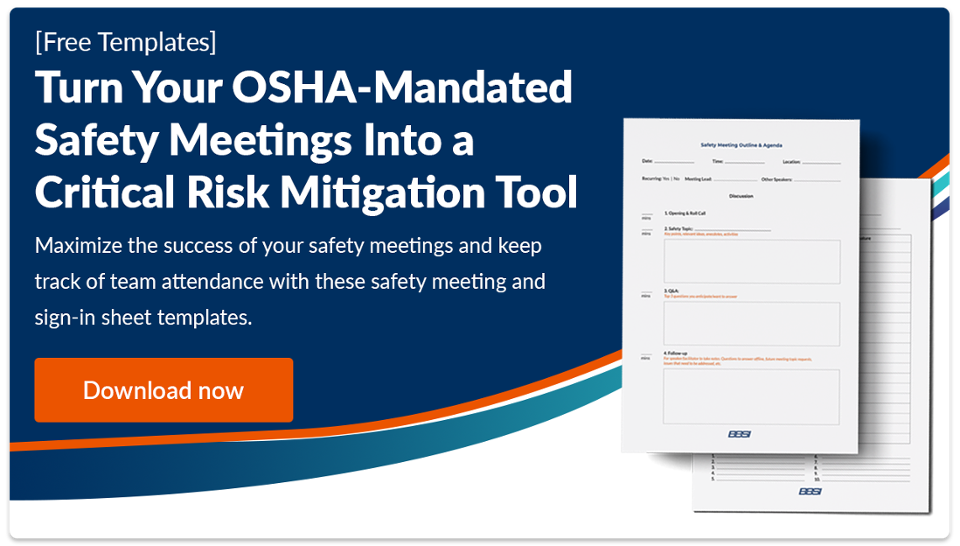
4 Steps for Structuring a Successful Safety Meeting [Free Templates]
Safety meetings are vital for preventing injuries in any work environment. They make sure everyone clearly understands the safety expectations and regulations specific to their industry and daily duties. Safety meetings even help a workplace’s overall culture by offering a platform for employees to provide input or air their safety grievances.
However, these benefits only come to fruition when you effectively structure and plan your safety meetings. Otherwise, you end up with attendees who tune you out and dread coming to the next meeting. If you feel like your safety meetings need improvement, or you’re not sure where to start, we've put together these four easy steps to help you get the most out of your safety meetings.
1. Prepare
To have a purposeful meeting and hold people's attention, you need to show them you’re invested in the topic and put effort into preparing for the meeting. Some of the best things you can do to prepare include:
Have a Good Facilitator
One of the most critical parts of planning a safety meeting is choosing the right facilitator. Having an authoritative speaker with a wealth of knowledge about the selected topic will command the attention and respect of your workforce. For example, you could bring in your safety manager, a foreman, or even the boss or owner of the company. Pick anyone you think will fit the audience and the topic.
If you're presenting to construction workers, you may choose someone with a blue-collar background over someone who's clearly from the corporate world. Your employees will tune out quickly if they sense the speaker has no experience with the topic or doesn’t understand what your crew does on a daily basis. You could even bring in a crew member as a co-facilitator if they know enough about the subject and speak well in front of crowds. Be wary, though — you don't want to lose meeting time due to a flustered co-facilitator. If they don’t have enough experience in the public speaking saddle, you may want to have them as support to add valuable tips and advice, instead of leading the meeting.
Make the Topic Relevant to Your Team
To start brainstorming relevant topics, identify hazards your team encounters on the job. These could be related to the team's specific assignment, an accident that happened on a recent job, a new piece of equipment, or even a topic they’ve suggested. Crowdsourcing topic ideas from your employees will keep them invested in the meeting and help you avoid overly repetitive discussions.
Safety meetings should also be a time for your team to discuss problems without fear of retaliation. The meeting might be the only time an employee is comfortable enough to express feeling unsafe in the workplace. Encourage them to be open and give them information that empowers them to step back from potentially dangerous conditions or tasks until it’s safe to proceed. Your employees want to know you care about their health and safety. They shouldn’t risk their lives because someone didn't listen to them.
Have Anecdotes Ready
If you have a story that's relevant to your topic and everyone is familiar with, use it to engage your audience. You could even refer to a common situation your employees will have stories about. For example, fall protection has been OSHA's most cited violation for the last 10 years. Introduce your topic with, "we all know someone who hasn’t worn a harness properly," and get them to relate to your subject from the get-go.
An anecdote can also give people a more vested interest. For example, if you talk about a safety issue that led to a death on the job, you add an emotional layer to your topic that will stick with your audience. Concern for themselves or their coworkers can help them realize safety procedures exist to help them, not to burden them.

Study the Topic
If you don't understand your topic, your audience will question why they should care. Utilize the wealth of online resources to study your topic and gather the information you need for your meeting. Two helpful sources to start with are:
- OSHA's website: OSHA has several free resources and eTools on its website with useful, detailed information and data on a number of topics
- YouTube: YouTube videos aren't only a good way to prepare — you could even include a short clip in your presentation to support your point
Build an Outline
After studying and gathering your thoughts, write up a short outline that consolidates all the work you've put in. This roadmap will help you stay on track while presenting, and can act as a handout for your audience to follow along.
You should keep your outlines simple. Include key points, relevant ideas, anecdotes, and avoid getting overly technical. If you include an OSHA code word-for-word, people will tune out.
2. Get the Timing Right
The timing of a meeting can strongly impact its effectiveness. Here are some things you should consider when scheduling your safety meeting.
Accommodate Schedules with Early Meetings
No specific time works for everyone's schedule, but you should find a time when most people are available. Nobody wants to go to a safety meeting while they’re in the middle of important work or at the end of a long day, so aim for a morning slot. Your audience will be fresher, and, depending on the job, a safety meeting before the start of a shift will prime the audience to focus on safety during their workday.
Not everyone is a morning person, so bring doughnuts or coffee to perk people up if you choose an early meeting.
Schedule for Regular Meetings
OSHA requires businesses to hold monthly or quarterly safety meetings. To help turn these meetings into a habit for everyone, try to have them monthly with consistent times, like before work on the fourth Wednesday of every month. This way, people can settle into a schedule.
Keep It Concise
Meetings should take 20 minutes. Any longer, and people start losing focus and miss the main point of the meeting. Your presentation may lose focus too.
If you plan for quick meetings, but they consistently run longer than expected, you might be getting sidetracked. Some ways you can keep meetings on track are by:
- Following along with your outline
- Knowing when to cut people off in discussions — don't let them get sidetracked either
- Speaking pithily — using short, impactful language
- Letting people know you will take a few questions (maybe five) and can answer any others at a later time via email or in-person
- Setting and enforcing clear boundaries
3. Deliver Clearly
No matter how well you know a topic, you won’t teach effectively if you don’t speak clearly. When you have to fit a complex subject into a 20-minute meeting, you need to have a clear idea of what you want to say.
Use your outline to help you. You can even allot a certain number of minutes to each section, so you know you have enough time to discuss the important topics. Other things to think about include:
Structure
Try to structure your meeting appropriately for the topic. For example, if you're talking about hazard labels, you might use the first five minutes to watch a video about updated labels, and then open the floor for discussion. In comparison, a different topic like harness safety would work better if you allow time for everyone to don and doff their equipment with your guidance.
When structuring meetings, you should always encourage team involvement in the topic.
Itineraries
Depending on the environment and your audience, itineraries could be very useful or not at all. For example, if you work in an office environment, sending out an itinerary will inform employees of the direction of the meeting and expectations, so they can keep their side of the discussion on track. However, if you have blue-collar workers, you're better off talking to the foreman and posting a reminder in a communal area.
In short, you should only hand out itineraries if you think attendees will get value out of them.
Attendee Preparation
It's good to encourage, and even expect teams to take preparation into their own hands and come up with questions or concerns about the topic ahead of time.
As the facilitator, don't just ask them if they understand what you're talking about and let them wave you on. Ask them to talk about it, and press until you know they understand the key points of the meeting.

4. Follow Up
It's always good to get feedback from the audience after your meeting. Ask them if they felt the meeting was helpful and if there's something they'd like to discuss next time. This feedback will help you improve your future meetings.
Some effective follow-up tasks and questions include:
Review Key Points
To make sure people got the right information out of the meeting, it's helpful to follow up on key points and to mention you're open to questions on these points. Some people are shy and may avoid asking questions in front of everyone else. If you welcome them and make sure they know there aren't any dumb questions, you can make sure everyone's on the same page.
FAQs No One Asked
Sometimes you may prepare for questions nobody ends up asking, or have something come up during the meeting that reminds you of other valuable information to share. You could hand out a list of these questions and information to flesh out people's understanding of the topic. If you do this though, make sure the questions do actually bring out new information.
Crowd-Source Ideas
Ask people what topics they'd like to discuss in future meetings, and check if they felt like the meeting structure helped them understand the topic. If they know that you're actually using their input and not just checking off boxes, they'll engage more with your meetings.
Ask Hard Questions
Ask the questions no one enjoys asking, like "Do you feel safe working here?" and, "Is there something we can do to make you feel safer?" When you give people the option to vent, you may discover pent-up feelings about issues you can help solve — or you could get valuable insight about the company to discuss with your boss.
How BBSI Can Help with Your Safety Meetings
When you partner with BBSI, you’ll have a dedicated Business Unit Team, including a Risk Consultant, that will audit your current safety meeting procedures and help you improve their structure so your meetings are as effective as possible. BBSI will also help identify relevant topics to focus on and provide leadership training to teach your leaders to run meetings more effectively.
Contact your local branch to learn how partnering with BBSI can prevent you from leaving your employees’ safety up to chance.
Disclaimer: The contents of this white-paper/blog have been prepared for educational and information purposes only. Reference to any specific product, service, or company does not constitute or imply its endorsement, recommendation, or favoring by BBSI. This white-paper/blog may include links to external websites which are owned and operated by third parties with no affiliation to BBSI. BBSI does not endorse the content or operators of any linked websites, and does not guarantee the accuracy of information on external websites, nor is it responsible for reliance on such information. The content of this white-paper/blog does not provide legal advice or legal opinions on any specific matters. Transmission of this information is not intended to create, and receipt does not constitute, a lawyer-client relationship between BBSI, the author(s), or the publishers and you. You should not act or refrain from acting on any legal matter based on the content without seeking professional counsel.

